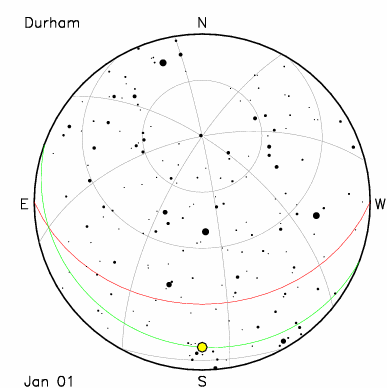 |
Department of Physics | User's Guide to the Night Sky |
Position of Midday Sun as seen from Durham through the Year

The animation shows the position of the Sun as seen from Durham at noon each day through the year. Hence it shows how the Sun's apparent position on the sky changes as seen from the Earth during one orbital period. The whole sky is shown with the thick black line being the horizon. The southern horizon is at the bottom and the northern horizon is at the top. The eastern horizon is on the left and the western to the right. The animation starts on 1st January.
Note how the Sun moves eastwards along the ecliptic (green line) with respect to the distant stars. The Sun crosses the celestial equator (red line) moving northwards on about 21st March (vernal equinox), reaches its highest point on about 21st June (summer solstice), crosses the celestial equator moving southwards on about 20th September (autumnal equinox), and reaches its low point on about 21st December (winter solstice).
The daily track of the Sun across the sky at the equinoxes and solstices can be seen in the following animations: equinox, summer solstice, winter solstice.
| User's Page | jrl |